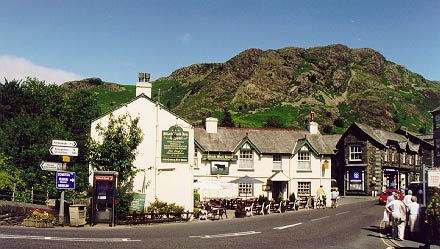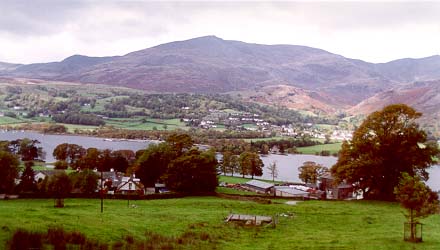

Until the copper mines, dating from Jacobean times, were revitalised about 1859, Coniston was a scattered rural commmunity. It was mainly settled around Coniston Hall, a 16th Century farmhouse with a display of mighty chimneys, built by the Fleming family, and now owned by the National Trust (though not open to the public).
Its best feature is The Old Man of Coniston, rising dramatically behind the houses when seen from the village centre. Coniston is a good centre for walkers and climbers, and those wanting to investigate the Tilberthwaite Slate quarries.
St Andrew's Church was completed in 1891, during a period of great prosperity for the community, when many wealthy patrons, including John Ruskin settled in the area. He lived for the last 30 years of his life at Brantwood, just across the lake. When he died, he was buried in St Andrew's graveyard, and his grave was marked with a large carved cross made from green slate from the local quarry at Tilberthwaite. It was designed by W.G. Collingwood his friend and secretary, who was an expert on Anglo-Saxon crosses, with symbols depicting important aspects of Ruskin's work and life. A year later W.G. Collingwood worked to set up an exhibition, now called the Ruskin Museum at the back of the Coniston Mechanics Institute, as a place to preserve any Ruskin mementos that could be found.

Coniston in the shadow of 'The Old Man of Coniston' (2635 ft)
There are two public launch services on Coniston Water, the Coniston Launch, and the National Trust's Steam Yacht Gondola. Both of these call at Brantwood.
The Monk Coniston estate, owned by Beatrix Potter, and given on her death to the National Trust, stretches from Coniston to Skelwith Bridge. It includes the famous beauty spot - Tarn Hows.
Donald Campbell broke the water speed record on Coniston Water in 1955,
and was killed attempting to regain it again in 1967. There is a memorial
to him on the village green, just opposite the car park, and information
about him in the Ruskin Museum.
Tourist Information Centre: Ruskin Ave, LA21 8EH. Tel: 015394 41533
Museum: The Ruskin Museum, Yewdale Rd. Tel: 015394 41164
URL: http://www.instinct-training.co.uk/ti/amb/coniston.htm
©11 Jul 2000. Instinct Training Ltd, Cockermouth, Cumbria, UK
Academic Year 2000/2001
© a.r.e.a./Dr.Vicente Forés López
©jenna little
Universitat de València Press
jenlit@alumni.uv.es
14171 Hipertextos y Literatura Inglesa
John Ruskin